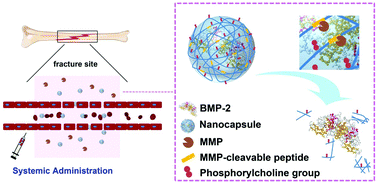Systemic administration of enzyme-responsive growth factor nanocapsules for promoting bone repair†
Abstract
Accelerating the healing of bone fractures by local delivery of growth factors possessing osteoinductive activity has been extensively demonstrated. Unfortunately, for some complex clinical fractures, such as osteoporotic vertebral compression fracture, it is not possible to adopt such a strategy because of access restrictions. Systemic administration of growth factors is considered to be an appropriate alternative method due to its easy operability and precise spatiotemporal compatibility at fracture sites. But this therapy method was hampered by the poor in vivo stability, inefficient distribution at the fracture site and potential side effects of growth factors. To address these challenges, we conceived a systemic delivery platform of growth factors based on nanocapsules, taking advantage of the unique physiological character of bone fracture, i.e., the malformed blood vessels and the over-expression of matrix metalloproteinases (MMPs). In this work, bone morphogenetic protein-2 (BMP-2), 2-(methacryloyloxy)ethyl phosphorylcholine (MPC) and the bisacryloylated VPLGVRTK peptide were respectively used as the model growth factor, monomer, and MMP-cleavable crosslinker. Nanocapsules were formed by in situ free radical polymerization on the surface of BMP-2 with MPC and peptides. The structure and function of BMP-2 were well maintained during the preparation process. BMP-2 nanocapsules (n(BMP-2)) were of uniform small size (∼30 nm) possessing a long circulation time (half-life is ∼48 h) and could be passively targeted to the fracture site through malformed blood vessels after systemic administration. Once accumulated at the fracture site, the shells of nanocapsules could be degraded by MMP and thus BMP-2 was released. Animal experiments proved that n(BMP-2) showed a better ability of bone repair than native BMP-2. In addition, n(BMP-2) showed a much lower inflammatory irritation. The results demonstrated that the systemic administration of growth factor nanocapsules could enhance their in vivo stability and fracture site delivery efficiency, realizing the efficient repair of a bone fracture. This rational delivery system may expand the bone repair types which can be administered with growth factors. Furthermore, the concept of taking advantage of the malformed vascular structure to deliver drugs potentially inspires researchers for the therapy of other diseases, especially sudden disease (such as cerebral hemorrhage).



 Please wait while we load your content...
Please wait while we load your content...